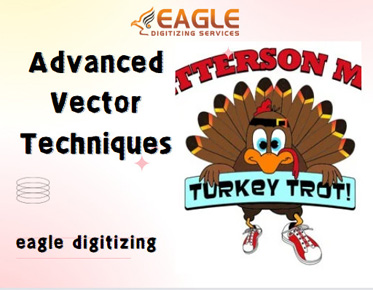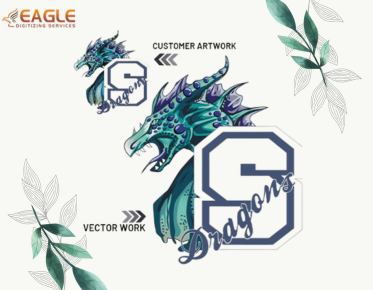Print Perfection: Why Vector Graphics Are Essential
In today’s visually driven world, high-quality printing has become a
pivotal aspect of media. From eye-catching advertisements to intricate
packaging designs, the demand for crisp, clear, and vibrant printed materials
is higher than ever. The quality of print directly impacts the effectiveness of
communication and the impression a brand makes. As media continues to evolve,
the pursuit of impeccable print quality remains a cornerstone for success,
making it essential for designers and printers to grasp the intricacies of
graphic design and printing technology.
For the top-notch online vector conversion, don't hesitate to get in touch with us.
Why
Understanding Vector Graphics is Crucial for Designers and Printers
Vector graphics are a fundamental element in the quest for
high-quality print. Unlike raster graphics, which are composed of pixels,
vector graphics are built using mathematical formulas to define shapes and
lines. This intrinsic property allows vectors to be scaled infinitely without
loss of quality. For designers and printers, understanding vector graphics is
not just advantageous; it’s essential. It ensures that every printed piece
retains its sharpness, detail, and color integrity, regardless of size. Mastery
of vector graphics empowers professionals to deliver print products that are
visually stunning and precisely aligned with their creative vision.
Applications
in Media Printing
Branding and Logos: The Role of
Vector Graphics in Consistent Brand Identity
Branding relies heavily on consistency, and vector graphics are vital
in achieving this. Logos, which are often the face of a brand, need to appear
uniformly across various media and sizes—from business cards to billboards. Vectors ensure that logos maintain their clarity and
sharpness, no matter how much they’re scaled. This consistency helps in
reinforcing brand identity and establishing a professional image. Vector
graphics allow for precise reproduction of logos and branding elements,
ensuring that they always look polished and cohesive, reinforcing brand
recognition at every touchpoint.
Posters and Flyers: Why Vector
Graphics Are Preferred for Promotional Materials
When it comes to posters and flyers, first impressions are crucial.
Vector graphics offer the sharpness and precision required for these
promotional materials to stand out. They allow for high-resolution prints that
capture every detail, from intricate designs to bold typography. The
scalability of vectors means that promotional materials can be printed in
various sizes without compromising quality. This flexibility is particularly
valuable for marketing campaigns that require a range of formats and
dimensions. Vector graphics ensure that every poster and flyer retains its
visual impact and effectiveness.
Packaging Design: How Vectors
Enhance the Visual Appeal and Accuracy
Packaging design is another area where vector graphics shine. The
intricate details and vibrant colors of the packaging need to be reproduced
accurately to appeal to consumers and convey the product’s essence. Vectors
provide the precision required for complex packaging designs, ensuring that
every element—from logos and text to patterns and images—looks flawless. This
accuracy extends to dielines and cut-outs, which are critical for packaging
functionality. By leveraging vector graphics, designers can create packaging
that is both visually appealing and functional, enhancing the overall consumer
experience.
Technical
Aspects of Vector Graphics
File Formats for Printing: EPS,
PDF, AI, and Others Explained
Choosing the right file format is crucial for ensuring print quality.
EPS (Encapsulated PostScript) and PDF (Portable Document Format) are among the
most commonly used formats for vector graphics. EPS files are widely accepted by
printers and maintain high quality, making them ideal for complex designs. PDFs
offer versatility and can embed fonts and images, ensuring that designs appear
as intended across different systems. Adobe Illustrator (AI) files are native
to Illustrator and retain all vector properties, but they may require
conversion for printing. Understanding these formats and their applications
helps in selecting the best option for each print job, ensuring optimal
results.
Color Models and Profiles:
Ensuring Color Accuracy in Vector Graphics
Color accuracy is paramount in printing, and understanding color
models and profiles is key to achieving it. The CMYK color model, which stands
for Cyan, Magenta, Yellow, and Key (Black), is used in printing and differs
from the RGB model used for screens. Vector graphics must be converted to CMYK
to ensure that colors are printed as intended. Additionally, color profiles
such as ICC profiles help in managing color consistency across different
devices and printers. Proper color management ensures that the final print
matches the designer’s vision, maintaining the intended look and feel.
The Role of Pantone Colors: How
Vectors Support Spot Color Printing
Pantone colors are standardized hues used in spot color printing.
Unlike CMYK, which mixes colors on the printer, Pantone colors are pre-mixed
inks that provide consistent and precise colors. Vector graphics support
Pantone colors, allowing designers to specify exact shades and achieve accurate
color reproduction. This is especially important for branding and packaging,
where specific colors are integral to the design. By using Pantone colors in
vector graphics, designers can ensure that their prints have the exact color
fidelity required for brand consistency and visual appeal.
Preparing
Vector Graphics for Print
Resolution and Size: What You
Need to Know Before Sending Files to Print
Before sending vector graphics to print, it’s crucial to consider
resolution and size. While vector graphics themselves are
resolution-independent, the output resolution for rasterized elements or
embedded images within the vectors must be high enough to ensure clarity. A
resolution of 300 DPI (dots per inch) is usually recommended for printing.
Additionally, the size of the artwork should be set to match the final print
dimensions, with appropriate margins to account for bleed areas. Proper
preparation ensures that the final print is sharp and accurately reflects the
design.
Bleed and Crop Marks: Ensuring
Your Design Fits the Final Print Size
Bleed and crop marks are essential for ensuring that your design fits
perfectly in the final print. Bleed refers to the area of the design that
extends beyond the edge of the page, which is trimmed off after printing to
avoid white edges. Crop marks indicate where the paper should be cut to achieve
the final size. Including these elements in your vector graphics file ensures
that the design extends to the edges and that any trimming is accounted for,
resulting in a clean and professional-looking print.
Proofing and Pre-Press Checks:
Avoiding Common Pitfalls in Vector Printing
Proofing and pre-press checks are crucial steps in the printing
process to avoid errors and ensure quality. Proofing involves reviewing a
sample of the print to check for color accuracy, layout issues, and any
potential problems. Pre-press checks include verifying file formats,
resolution, and color settings. By conducting thorough proofing and pre-press
checks, you can catch any issues before the final print run, ensuring that the
end product meets your expectations and maintains the integrity of your design.
Vector
Advantages Over Raster Graphics
No Pixelation: How Vectors Avoid
Common Issues with Raster Images
One of the key advantages of vector graphics over raster images is the
absence of pixelation. Vector graphics are resolution-independent, meaning they
can be scaled to any size without losing quality or becoming pixelated. This
makes vectors ideal for applications where size may vary, such as large-format
prints or detailed designs. In contrast, raster images, which are composed of
pixels, can become blurry or pixelated when scaled up. The clarity and
sharpness of vector graphics ensure that prints remain crisp and detailed,
regardless of size.
Smaller File Sizes: Why Vector
Graphics Are More Efficient for Printing
Vector graphics often have smaller file sizes than raster images. This
efficiency is due to the mathematical nature of vectors, which store geometric
data rather than pixel information. Smaller file sizes result in faster processing
and easier handling, particularly for large or complex designs. This efficiency
can also lead to cost savings in printing, as smaller files require less data
processing and storage. The streamlined nature of vector graphics makes them a
practical choice for high-quality printing and large-scale projects.
Easy Editing and Revisions: How
Vectors Simplify Design Adjustments
Editing and revising vector graphics is generally more straightforward
than working with raster images. Since vector graphics are based on
mathematical equations, individual elements can be easily adjusted or modified
without affecting the overall quality. This flexibility allows for quick
changes and iterations, making it easier to refine designs or make last-minute
adjustments. The ease of editing vectors streamlines the design process and
ensures that updates can be implemented efficiently, saving time and reducing
the likelihood of errors.
Optimizing
Vector Graphics for Different Media
Print Media vs. Digital Screens:
Adjusting Vectors for Various Uses
Vector graphics can be used across various media, but adjustments may
be needed for different applications. For print media, vectors should be
prepared with considerations for color profiles, resolution, and print size.
For digital screens, vectors may need to be optimized for screen resolution and
color settings. Ensuring that vectors are appropriately adjusted for their
intended use helps maintain quality and effectiveness across different
platforms. Understanding the requirements of both print and digital media
allows for versatile and impactful use of vector graphics.
Adapting Designs for Different
Print Processes: Offset, Digital, and Screen Printing
Different print processes have unique requirements for vector
graphics. Offset printing, for example, involves transferring ink from plates
to paper and may require specific color separations. Digital printing uses
digital files and can handle complex designs with fewer constraints. Screen
printing involves creating stencils for ink application and may require
adjustments to the artwork for accuracy. Adapting vector designs to suit these
various print processes ensures that the final product meets the intended
quality and specifications, regardless of the printing method used.
Special Printing Techniques: How
Vectors Support Spot UV, Foil Stamping, and More
Special printing techniques, such as spot UV coating and foil
stamping, can significantly enhance the visual appeal of printed materials.
Eagle Digitizing provides vector graphic conversionservices, and vector graphics are particularly well-suited for these
techniques due to their precision and scalability. Spot UV coating adds a
glossy finish to specific areas of a print, while foil stamping applies
metallic or colored foil to create a striking effect. Vectors enable precise
control over the application of these techniques, ensuring that they align
perfectly with the design and produce the desired outcome. By incorporating
these special printing techniques, designers can create truly unique and
eye-catching print materials. Vector graphics hold the key to unlocking
superior printing results and achieving exceptional design effects. By
mastering the technical aspects, understanding their applications, and staying
updated with industry advancements, designers can fully harness the potential
of vectors. Embrace the power of vector graphics, along with the services
offered by Eagle Digitizing, to elevate your print media projects and create
stunning, high-quality prints that leave a lasting impression.



